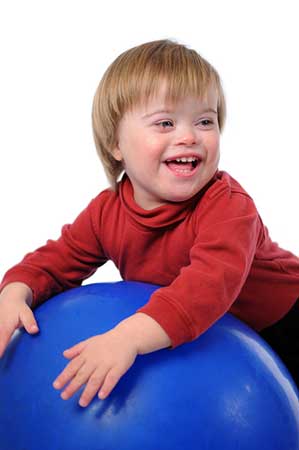Does your son or daughter have trouble with everyday tasks that other child seem to handle easily? This is a situation where an occupational therapist can often help.
 Some activities, whether at school, in the community or at home, can present major problems to a child with development delays or disabilities. The goal of occupational therapy is to navigate day-to-day actions as efficiently as possible.
Some activities, whether at school, in the community or at home, can present major problems to a child with development delays or disabilities. The goal of occupational therapy is to navigate day-to-day actions as efficiently as possible.
Children can experience difficulties in several ways. Here is a look at how an occupational therapist can help.
Developmental Delay
Some children are behind their peers when it comes to specific skills. A developmental delay means the child is late meeting specific development milestones or does not yet have a group of skills that most kids have at that age.
For example, perhaps your child isn’t crawling, sitting or walking when others his age are. Or perhaps she can’t seem to learn skills or information like others in her age group. Maybe your son doesn’t have the social skills or ability to play appropriately like others his age.
Fine Motor Skills
When a child picks up a spoon or holds a small object in her hands, she has fine motor skills. These involve small actions with the toes, tongue, lips, fingers and wrists.
These struggles can take many forms. Here are some examples:
- Picking up a pencil and holding it
- Coloring and drawing
- Prewriting shapes and tracing
- Not having a dominant hand in the age appropriate timeframe
- Maneuvering puzzle pieces and toys
- Using silverware or straws when others his or her age are able to
- Forming numbers and letters
- Staying away from games and activities that use fine motor skills
Movement, Strength and Balance
Gross motor skills deal with movement, strength and balance activities, using larger muscle groups. This includes movement and coordination with arms, legs and other parts of the body.
Children who have trouble with gross motor skills appear uncoordinated and clumsy, and often have trouble with things like:
- Balancing
- Going up and down stairs
- Coordinating both left and right sides of the body
- Figuring out left and right
- Playing with a ball
Children with gross motor skill problems often have either higher or lower muscle tension and resistance, and muscle tone, than what is age appropriate.
They often show:
- Fear when their feet are off the ground
- Avoidance when it’s time for games that require movement, strength and balance
- Crossing the body’s midline when playing and performing tasks
Visual Processing
Seeing actually involves sight plus making sense of what a person sees. Called visual processing, it is the way a person’s brain makes sense of visual information.
Children who have trouble with visual processing often have difficulty with these tasks:
- Figuring out space and the size of letters
- Tracking visually and crossing midline
- Copying from a board, paper or screen
- Recognizing a letter or number
- Finding one item in a group of items
- Figuring out right and left
- Making a copy of a letter or shape
- Having trouble making eye contact
- Losing his place when reading or copying
Oral Motor and Oral Sensory
 Problems with oral motor or sensory skills involve muscles in the lips, tongue, soft palate and jaw. When a child is developmentally delayed in this area, he or she often:
Problems with oral motor or sensory skills involve muscles in the lips, tongue, soft palate and jaw. When a child is developmentally delayed in this area, he or she often:
- Drools more than normal
- Has trouble lifting and holding a cup when others his age do
- Gets tired after eating
- Mouths his toys or other items when it is no longer age appropriate
- Drips food or liquid from his mouth when eating and drinking, more than what is considered age appropriate
- Eats just certain types of food or textures of food to an excessive degree
- Has trouble using a straw when others his age use them
- Chews food using his front teeth, not his molars
- As a baby, wants very long breast or bottle feedings
- As a baby, drips excessively from his lips when feeding
Sensory Processing
Sensory processing means figuring out the information that a person’s senses provide, like smell and sound. If your child often seems oversensitive to his or environment, it may be a problem with sensory processing.
Common problems include:
- Reacting intensely to touch, movement or sound
- Constant jumping, bumping, moving and crashing
- Having trouble handling change
- Showing less than normal response to specific sensations, like a high tolerance for pain or not noticing cuts and bruises
- Calming herself or himself when upset
- Getting distracted too easily by sights and sounds
- Reacting with very strong emotions
Social Interaction
Children need social interaction skills to get along with others and develop good relationships. A child with delayed social interaction skills often display these types of problems:
- Slow with language skills
- Problems coping in school
- Difficulty engaging with family and other children socially
- Tendency to focus on just one subject like dinosaurs, space, trains, etc.
- Troubles adjusting to new environments
Learning Challenges
A common developmental delay is a learning disability, or challenge. It can take a multitude of forms, like:
- Getting distracted easily
- Reversing letters and numbers, even after age 7
- Controlling impulsivity poorly
- Finding concentration and focus in the classroom very hard
- Learning new information with great difficulty
- Being either hyperactive or low energy
- Falling behind with homework
- Feeling very tired after school work
- Trouble figuring out directions and finishing jobs
Play Skills
Play is a child’s work. It’s how she and he figure out the world, learn how to get along with people, gain confidence and solve problems.
Symptoms of developmental delay with play skills include:
- Problems with imitative play
- Not understanding sharing and taking turns
- Not exploring toys in a suitable way
- Repeatedly doing one type of play for hours at a time, like lining up toys
- Needing help to initiate play
- Not joining in with other kids when playing
- Not staying with one activity, but instead jumping from one interest to another
The symptoms listed for each area of development are common examples. But each child is different, each has his or her own pace for development. But if you feel that these examples reflect problems your child is having, an occupational therapist may be able to help.
Child Development Checklists and Developmental Sequences
If you would like more information on what may or may not be normal development, please visit our Motor and Sensory Development Checklist page.
Do you have more questions?
If you think your child may qualify for our services, or if you’re just not sure, see How to Obtain Services. Or, just ask us! Call 928-776-9285, or email us using the form below.
